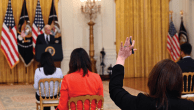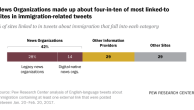Summary of Findings

News about the economy topped the public’s news interest last week, though many Americans also closely tracked the fallout from the midterm elections and the debate over enhanced security measures at the nation’s airports.
About three-in-ten (29%) say they followed news about the economy more closely than other major stories, while 20% say they followed news about the election outcome most closely. At the start of a busy holiday travel period, 14% say they most closely followed news about tougher passenger screening procedures at airports, according to the latest News Interest Index survey conducted Nov. 18-21 among 1,004 adults.
The media divided coverage among top stories, including the economy (11% of coverage) and the election outcome (9%), according to a separate analysis by the Pew Research Center’s Project for Excellence in Journalism. News about airport security screening procedures made up 6% of the newshole measured by PEJ, while coverage of the situation in Afghanistan accounted for 7%.
Plurality Sees Press Coverage of Obama as Fair

Currently, 46% say they think press coverage of President Obama has been fair, 23% say coverage has been too easy and 21% say it has been too tough.
In September, 37% said they thought coverage had been fair, 27% thought coverage was too easy and 23% said it was too tough. Responses to this question have fluctuated only modestly through 2010.
About four-in-ten Democrats (41%) say coverage has been too tough, matching the number that said this in September. Currently, 47% say coverage has been fair, up from 36% shortly after Labor Day; 5% say coverage has been too easy. About one-in-ten (12%) said this in September.

Among Republicans, half (50%) say coverage has been too easy, matching the number that said this in September. Roughly four-in-ten (39%) say coverage has been fair, while just 5% say it has been too tough. In September, 34% said coverage had been fair and 6% said it had been too tough.
Currently, 51% of independents say coverage of the president has been fair, up from 40% in September. About a quarter of independents (23%) say coverage has been too easy, while 15% say it has been too tough. In September, 28% said coverage was too easy and 19% said it was too tough.
Most Aware of Stir over Energy Drinks with Alcohol

Nearly eight-in-ten Americans (79%) say they heard at least a little about a warning by the Food and Drug Administration (FDA) that caffeinated alcoholic beverages are unsafe. About four-in-ten (42%) say they heard a lot about this, while 37% say they heard a little.
More say they heard about the energy drink warning than said they heard about graphic warning labels for cigarette packages proposed by the FDA one week earlier. Just 17% said they heard a lot about the proposed new labels; 38% heard a little.
Unlike most news stories, the FDA’s warnings about energy drinks resonated with young people. Nearly half (46%) of those younger than 30 say they heard a lot about these reports, which is comparable to the percentage of those older than 50 (48%) who heard a lot about the warnings.
Several political figures in the news last week registered similar amounts of public awareness. More than six-in-ten (64%) heard either a lot (31%) or a little (33%) about the House Ethics Committee finding New York Congressman Charlie Rangel guilty of ethics violations. A similar majority (62%) heard at least a little about Sarah Palin’s new television show on TLC (25% heard a lot, 37% a little) and close to six-in-ten (59%) heard a lot (24%) or a little (35%) about Alaska Sen. Lisa Murkowski winning her write-in campaign for re-election to the U.S. Senate.
Republicans (30%) and Democrats (27%) were about equally likely to say they heard a lot about Palin’s new reality show. That also is the case for Murkowski’s write-in win (30% of Republicans and 24% of Democrats heard a lot about this).
More Republicans (41%) than either Democrats (27%) or independents (30%) say they heard a lot about the ethics panel’s findings on the Rangel charges. The committee has recommended that the full House censure Rangel.
The Week’s News
For the first time since the Nov. 2 elections, more say they tracked news about the economy most closely (29%) than news about the elections (20%). Nearly half (46%) say they followed news about the economy very closely, while 40% say they followed news about the election outcomes that closely. News about the elections and their ramifications accounted for 9% of coverage.
A third of the public (33%) says they followed the debate over new airport screening procedures very closely, while 14% say this was the news they followed most closely. News about airport security screening made up 6% of coverage.
More than a quarter (27%) say they very closely followed news about the situation in Afghanistan; 10% say this was the news they followed most closely. News about Afghanistan accounted for 7% of coverage.
News about the verdict in the trial of the first former Guantanamo detainee in a civilian court attracted less attention. About one-in-ten (12%) say they followed the outcome of the trial of Ahmed Khalfan Ghailani very closely, while 2% say this was the news they followed most closely. The trial accounted for 2% of coverage.

Republicans tracked each of these stories – except the debate over airport security – more closely than Democrats. For example, 54% of Republicans say they followed news about the election outcome very closely, compared with 39% of Democrats and 35% of independents. Republicans tracked election news more closely than Democrats throughout the campaign as well.
Nearly two-in-ten Republicans (19%) followed the terror trial very closely, compared with 9% of Democrats and 10% of independents.
About one-in-ten (11%) of the public say they followed news about Prince William’s engagement to Kate Middleton very closely; 6% say this was the news they followed most closely. The royal engagement accounted for 4% of the coverage measured by PEJ. More women than men say they tracked this story very closely (16% vs. 7%). That is especially true among those 50 and older. In that age group, 22% of women say they followed this news very closely, compared with 9% of men.
These findings are based on the most recent installment of the weekly News Interest Index, an ongoing project of the Pew Research Center for the People & the Press. The index, building on the Center’s longstanding research into public attentiveness to major news stories, examines news interest as it relates to the news media’s coverage. The weekly survey is conducted in conjunction with The Project for Excellence in Journalism’s News Coverage Index, which monitors the news reported by major newspaper, television, radio and online news outlets on an ongoing basis. In the most recent week, data relating to news coverage were collected November 15-21, and survey data measuring public interest in the top news stories of the week were collected November 18-21, from a nationally representative sample of 1,004 adults.
About the News Interest Index
The News Interest Index is a weekly survey conducted by the Pew Research Center for the People & the Press aimed at gauging the public’s interest in and reaction to major news events. This project has been undertaken in conjunction with the Project for Excellence in Journalism’s News Coverage Index, an ongoing content analysis of the news. The News Coverage Index catalogues the news from top news organizations across five major sectors of the media: newspapers, network television, cable television, radio and the internet. Each week (from Monday through Sunday) PEJ compiles this data to identify the top stories for the week. (For more information about the Project for Excellence in Journalism’s News Coverage Index, go to www.pewresearch.org/pewresearch-org/journalism.) The News Interest Index survey collects data from Thursday through Sunday to gauge public interest in the most covered stories of the week.
Results for this survey are based on telephone interviews conducted under the direction of Princeton Survey Research Associates International among a national sample of 1,004 adults living in the continental United States, 18 years of age or older, from November 18-21, 2010 (670 respondents were interviewed on a landline telephone, and 334 were interviewed on a cell phone, including 151 who had no landline telephone). Both the landline and cell phone samples were provided by Survey Sampling International. Interviews were conducted in English.
The combined landline and cell phone sample are weighted using an iterative technique that matches gender, age, education, race, Hispanic origin, region, and population density to parameters from the March 2009 Census Bureau’s Current Population Survey. The sample is also weighted to match current patterns of telephone status based on extrapolations from the 2009 National Health Interview Survey. The weighting procedure also accounts for the fact that respondents with both landline and cell phones have a greater probability of being included in the combined sample and adjusts for household size within the landline sample. Sampling errors and statistical tests of significance take into account the effect of weighting. The following table shows the error attributable to sampling that would be expected at the 95% level of confidence for different groups in the survey:

In addition to sampling error, one should bear in mind that question wording and practical difficulties in conducting surveys can introduce error or bias into the findings of opinion polls.




